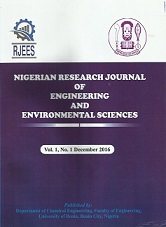Optimization of Kiln Feed Chemical Composition for Clinker Formation in BUA Sokoto Cement Plant
Authors: Nuhu, S., Abubakar, H. A. And Mukhtar, B.
DOI Info: http://doi.org/10.5281/zenodo.10441687
ABSTRACT
Inappropriate chemical composition of cement raw materials has significant impact on the cost of cement production, and clinker formation. This paper presents optimization of the kiln feed chemical compositions for clinker formation with minimum cost, while fulfilling the critical clinker quality parameters. Mathematical model that relates raw material and fuel mix chemistry to clinker chemistry was developed and solved using linear programming method to achieve the objective. The study considered BUA Cement Plant Sokoto, as a case study. It has 5 types of feed materials with different limestone quality grades grouped into stockpiles 1, 2, 3, 4 and 5 with the fifth stockpiles being a corrected material. Based on the linear programming simulation, the optimized kiln feed was achieved at the cost of $12.63 per ton of kiln feed with 74.90% of limestone, which when compared with the corresponding production cost from the company for the same feed obtained to be $15.71 per ton with 76.31% of limestone. With 74.90% of limestone is expected to lead to a saving of $3.08 per ton of kiln feed. The clinker quality parameters achieved from this study are 97.26% of lime saturation factor (LSF), 2.45% of silica modulus (SM) and 1.56% of alumina modulus (AM), which satisfied the industrial quality standard. The clinker minerals corresponding to these parameters were calculated to be 63.17% of C3S, 11.21% of C2S, 8.57% of C3A and C4AF. The results obtained show that the models can minimize the raw material cost without trading-off the clinker quality.
Affiliations: Department of Chemical Engineering, College of Engineering, Umaru Ali Shinkafi Polytechnic, Sokoto, Nigeria.
Keywords: Cement, Clinker, Limestone, Material, Optimization
Published date: 2023/12/30









